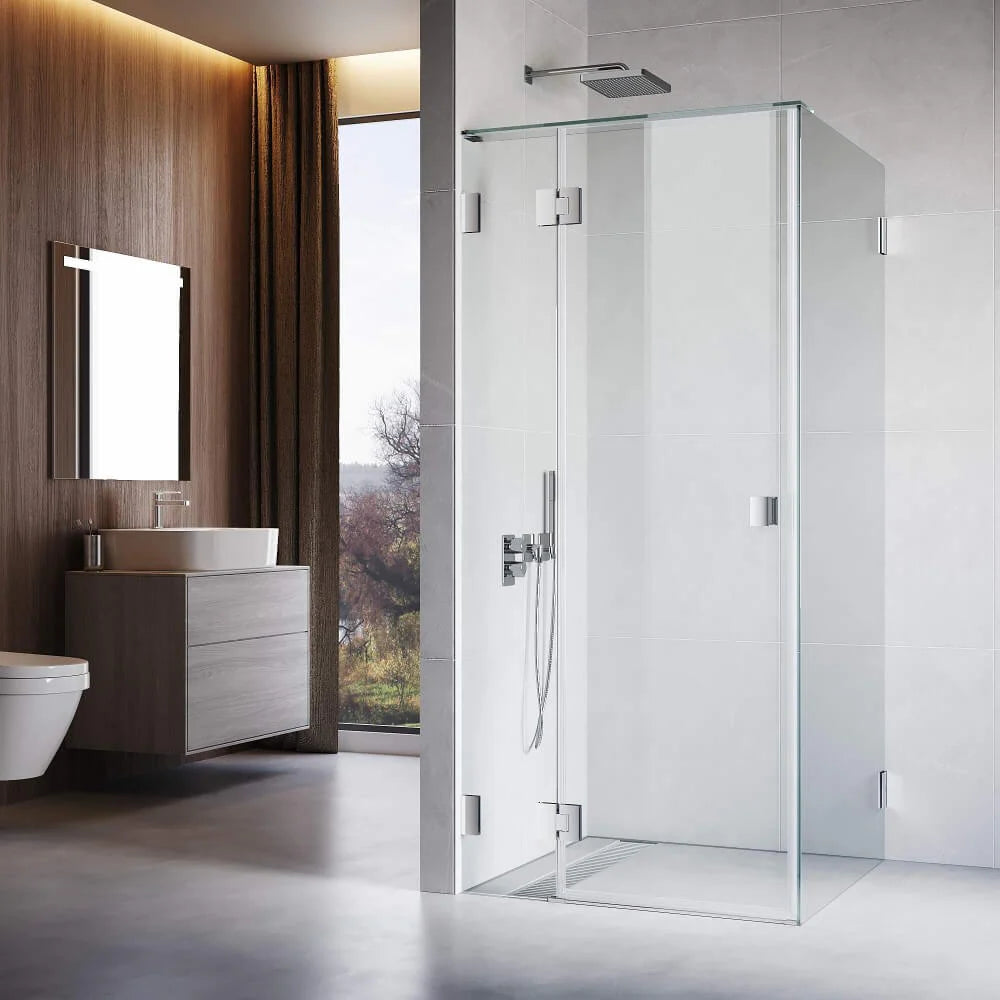Choosing the right shower door can significantly impact the functionality and aesthetics of your bathroom. This article aims to guide you through the process, ensuring you make an informed decision that enhances your bathroom's appeal and utility.

How to Measure for a Shower Door
The first step in selecting a shower door is accurate measurement:
- Measure the Width: Begin by measuring the width of your shower opening at three points: the top, middle, and bottom. Record these measurements to the nearest 1/16th of an inch. Because walls can be uneven, using the largest of these measurements ensures the door will fit across the entire opening. Common widths for shower doors range from 22 inches for narrow walk-in showers to 60 inches for larger spaces, typically accommodating single doors, sliding, or bi-fold designs.
- Measure the Height: Next, measure the height from the top of the shower base or bathtub edge to the top of the space where the door will be installed. This ensures the door will be tall enough to contain water spray effectively. Standard shower doors are usually 72 inches tall, but heights can range from 65 inches to 78 inches, depending on the design and level of coverage needed.
Standard shower door sizes are typically designed to fit openings from 22 inches wide for smaller showers up to 60 inches wide for larger showers. In terms of height, most standard doors are around 72 inches tall, providing adequate coverage for the average shower.
Check this to conversion formula for inch and mm.
Shower Door Styles
Shower doors come in various styles, each offering different benefits:
- Sliding Doors: These are a godsend for compact bathrooms where every inch of space matters. Sliding doors glide smoothly along a track,eliminating the need for clearance space that swinging doors demand. Their practicality doesn't come at the expense of style; modern designs offer sleek and minimalistic options that can make a small bathroom look more spacious and organized.
- Pivot Doors: For those with a bit more space to spare, pivot doors offer an elegant solution. They operate on hinges and swing outward, providing a generous entry space. This style suits classic to contemporary bathrooms and is often chosen for its ability to create a bold statement with a simple mechanism.
- Bi-fold Doors: Ingeniously combining the space-saving benefit of sliding doors with the accessibility of pivot doors, bi-fold doors fold in on themselves, maximizing your entry space without requiring the room outside the shower that pivot doors do. They're particularly suitable for mid-sized bathrooms where space is at a premium, but a larger opening is desired.
- Fixed Panels with Door: Ideal for larger bathrooms, this configuration typically involves a stationary glass panel paired with a pivot or hinged door. It's a choice that speaks to minimalist elegance, offering a clean, uncluttered look while providing ample access to the shower space.


When choosing a shower door style, consider how your bathroom is laid out and how much space you have available. Think about your daily routine and which door type would best support it, ensuring functionality doesn't take a backseat to aesthetics.
Glass Thickness and Type
The glass in your shower door isn't just a barrier to keep water in; it's a design element that can dramatically affect the look and feel of your bathroom. Standard glass thickness ranges from 1/4 inch to 1/2 inch. Thicker glass, often used in frameless designs, adds a touch of luxury and sophistication, providing a sturdier feel and requiring less hardware.
- Clear Glass: It's all about openness and light. Clear glass allows light to flow freely, making your bathroom appear larger and more airy.
- Frosted or Textured Glass: If privacy is a priority, frosted or textured glass obscures visibility while still letting light pass through, offering the best of both worlds.
- Tinted Glass: For a touch of personality and style, tinted glass can introduce color and mood into your bathroom space,adding an artistic element to your shower.For additional inspiration on creating a vibrant bathroom,explore these colorful shower screen makeover tips.
Safety is paramount, so ensuring that the glass is tempered is non-negotiable, as it breaks into smaller, less harmful pieces if shattered.

Frame Style: Framed vs. Semi-Frameless vs. Frameless
- Framed Shower Doors: Encased in metal on all sides, framed shower doors are celebrated for their reliability and durability. They're a budget-friendly option that doesn't skimp on design versatility, capable of fitting into a variety of bathroom decors.
- Semi-Frameless Shower Doors: Striking a balance between the sleek look of frameless doors and the strength of framed ones, semi-frameless doors use metal framing where necessary but minimize its appearance. They offer a modern look without the higher price tag of completely frameless options.
- Frameless Shower Doors: The epitome of modern bathroom design, frameless shower doors provide an uninterrupted view of your shower interior, promoting a sense of spaciousness. Made from thicker glass to compensate for the lack of framing, they are a premium option that elevates the look of any bathroom.
Each frame style comes with its set of advantages, affecting not just the look of your shower door but also its maintenance needs and overall cost. Your choice should harmonize with your bathroom's overall design theme and your personal preferences, ensuring that aesthetics, functionality, and budget align seamlessly.
Final Words
Choosing the right shower door involves a balance of functional, aesthetic, and budgetary considerations. By carefully measuring your space, selecting a style that complements your bathroom, considering the glass type and thickness, and deciding on a frame style, you can enhance your bathroom's functionality and appeal. Remember, the perfect shower door not only fits your bathroom's dimensions but also reflects your personal style and meets your needs for privacy and light.



